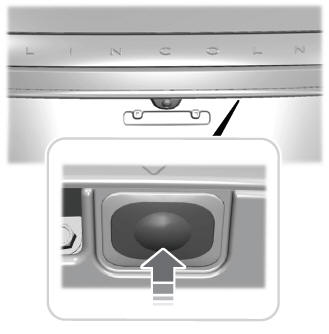Lincoln Aviator 2020-2025 Owners Manual / Doors and Locks / Locking and Unlocking / Opening the Luggage Compartment
Lincoln Aviator: Locking and Unlocking / Opening the Luggage Compartment
From Inside Your Vehicle
 With the transmission in park
(P),
press the button on the instrument
panel.
With the transmission in park
(P),
press the button on the instrument
panel.
With the Remote Control
 Press twice within three seconds
to open the luggage compartment.
Press twice within three seconds
to open the luggage compartment.
From Outside Your Vehicle

Press the exterior release button. Your vehicle must be unlocked or have an intelligent access key within 3 ft (1 m) of the luggage compartment.
 Battery Saver
Battery Saver
If you leave the courtesy lamps, interior
lamps or headlamps on, the battery saver
shuts them off 10 minutes after you switch
the ignition off.
Battery Saver for Intelligent Access Keys
If you leave the ignition switched on, it shuts
off when it detects a certain amount of
battery drain, or after 45 minutes...
 Closing the Luggage Compartment
Closing the Luggage Compartment
From Inside Your Vehicle
Press the button on the
instrument
panel to close the luggage
compartment.
With the Remote Control
Press twice within three seconds
to close the luggage compartment...
Other information:
Lincoln Aviator 2020-2025 Service Manual: General Procedures - Crankshaft Main Bearing Journal Clearance
Check NOTE: Refer to the appropriate Section 303-01 for the specification. NOTE: Crankshaft main bearing journals must be within specifications before checking journal clearance. Remove the crankshaft main bearing cap and crankshaft main bearing...
Lincoln Aviator 2020-2025 Service Manual: Diagnosis and Testing - F Clutch
Symptom Chart F Clutch For F clutch operation, REFER to: F Clutch (307-01A Automatic Transmission - 10-Speed Automatic Transmission – 10R60, Description and Operation). F Clutch Condition Possible Sources Action F clutch does not apply SSF is mechanically stuck OFF INSTALL a new solenoid...
Categories
- Manuals Home
- Lincoln Aviator Owners Manual
- Lincoln Aviator Service Manual
- Anti-Theft Alarm
- Fuel Quality
- Tire Change Procedure
- New on site
- Most important about car
Seatbelt Height Adjustment
WARNING: Position the seatbelt height adjuster so that the seatbelt rests across the middle of your shoulder. Failure to adjust the seatbelt correctly could reduce its effectiveness and increase the risk of injury in a crash.
Adjust the height of the shoulder belt so the belt rests across the middle of your shoulder. Slide the adjuster up to raise the belt. Press the button and slide it down to lower the belt.
Copyright © 2025 www.liaviator2.com
